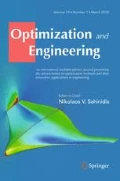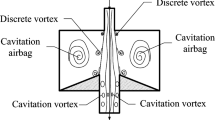Abstract
This work presents multi-objective optimization of an aspirating smoke detection system which uses the pipeline to transport air sample from the sampling points to the analysing module. On the basis of 3D computational fluid dynamics simulation it has been shown that the smoke transport will not always take place in the centre of the pipe and that one dimensional analysis is not able to provide information in which layer smoke transport will take place. Consequently, velocity from the layer at the distance of 0.95R from the pipe centreline was taken as an input for calculation of the transport time to bind the calculation on the safe side. By employing the multi-objective optimization approach, balancing of specific transport time and volume flow at the sampling points’ location was achieved through pipeline configuration variation with respect to pipe diameters and the position of branches along the main pipe. Objective function was assembled from the flow rate function and transport time function using the weighted sum method. Results for five different values of weight factor have been discussed. After reaching weight factor value of 0.75, configuration reached requested sensitivity, and further increase of weight factor enabled more uniform flow across the network without deterioration of transport time.
















Similar content being viewed by others
Abbreviations
- v, v avr (m/s):
-
Velocity, average velocity
- \(r,R\) (m):
-
Radius
- \(n\) (–):
-
Parameter
- Re (–):
-
Reynolds number
- \(a, \, b,{\text{ c}}\) (–):
-
Constants
- \(\nu\) (m2/s):
-
Kinematic viscosity
- \(h,h_{lin} ,h_{loc}\) (m):
-
Hydraulic head, hydraulic head of losses (linear and local)
- \(h_{12} ,h_{\bmod }\) (m):
-
Hydraulic head of the pipe, module head
- \(p\) (Pa):
-
Pressure
- \(\rho\) (kg/m3):
-
Density
- L (m):
-
Length of the pipe
- O vm(–):
-
Flow rate ratio
- Q (m3/s):
-
Volume flow
- Q m, Q v, Q f (m3/s):
-
Volume flow of module, fan and filter
- g (m/s2):
-
Gravity constant
- V, F, K (–):
-
Pressure loss coefficients of fan, filter and chamber
- d (m):
-
Pipe diameter
- t, t avr , t 0.95 , (s):
-
Time, mean time, time near wall
- t nor (–):
-
Normalized transport time
- T avr (s):
-
Sum of mean times
- K (–):
-
Parameter
- x, y, z (m):
-
Cartesian coordinates
- r (m):
-
Vector from origin to curve point
- s x , s y , s z (m):
-
Component of direction vector
- f, f t, f Q (–):
-
Dimensionless objective functions
- A (–):
-
Matrix of inequality constrain
- d, x (m):
-
Vector of project variables
- CFL (–):
-
Courant–Friedrichs–Lewy number
- w (–):
-
Weighing factor
- y (kg/kg):
-
Mass fraction
References
Alexias P, Giannakoglou KC (2019) Optimization of a static mixing device using the continuous adjoint to a two-phase mixing model. Optim Eng. https://doi.org/10.1007/s11081-019-09466-x
Cafaro DC, Cerdá J (2017) Short-term operational planning of refined products pipelines. Optim Eng 18:241–268. https://doi.org/10.1007/s11081-016-9330-5
Cole M (1999) Modelling of disturbed flow regimes in aspirated pipe systems. Victoria University of Technology, Footscray
Duque N, Duque D, Saldarriaga J (2016) A new methodology for the optimal design of series of pipes in sewer systems. J Hydroinformatics 18:757–772. https://doi.org/10.2166/hydro.2016.105
Fontecha JE, Cano NA, Velasco N, Munoz F (2016) Optimal sectioning of hydrocarbon transport pipeline by volume minimization, environmental and social vulnerability assessment. J Loss Prev Process Ind 44:681–689. https://doi.org/10.1016/j.jlp.2016.07.017
Idelchik IE (2008) Handbook of hydraulic resistance, 4th edn. Research Institute for Gas Purification, Moscow
Launder BE, Spalding DB (1974) The numerical computation of turbulent flows. Comput Methods Appl Mech Eng 3:269–289. https://doi.org/10.1016/0045-7825(74)90029-2
Liu F, Zhao Z, Yao HW, Liang D (2013) Application of aspirating smoke detectors at the fire earliest stage. In: Procedia Eng. 671–675
Liu Wei; Xu LLJ (2017) Seismic design of water distribution networks using auto-generation techniques. Struct Infrastruct Eng Maint Manag Life-Cycle Des Perform. https://doi.org/10.1080/15732479.2016.1212900
Oka K, Itō H (2005) Energy losses at tees with large area ratios. J Fluids Eng 127:110. https://doi.org/10.1115/1.1852475
Qian Z, Cao L, Su W, et al (eds) (2012) Recent advances in computer science and information engineering, vol 3. Springer, Berlin
Shampine LF (2008) Vectorized adaptive quadrature in MATLAB. J Comput Appl Math 211:131–140. https://doi.org/10.1016/j.cam.2006.11.021
Shixing L, Wei LXY, Changzheng C, et al (2014) Aspirating fire detection system with high sensitivity and multi-parameter. In: 2014 International conference on information science, electronics and electrical engineering. IEEE, pp 400–404
SystemSensor (2015) Applications guide: aspirating smoke detection. St. Charles, Illinois
Taylor, G., S. Cooper, A. D’Agostino, N. Melly A, Cleary T (2016) Determining the effectiveness, limitations, and operator response for very early warning fire detection systems in nuclear facilities. Wahington
Torres MN, Fontecha JE, Zhu Z et al (2020) A participatory approach based on stochastic optimization for the spatial allocation of sustainable urban drainage systems for rainwater harvesting. Environ Model Softw 123:104532. https://doi.org/10.1016/j.envsoft.2019.104532
Unny SAA-NT (1980) Developing laminar flow in the inlet length of a smooth pipe. Flow Turbul Combust. https://doi.org/10.1007/bf00411891
Versteeg H (2000) Introduction to fluid mechanics; flow meas. Instrum 11:51–52
Vieira Pombo A, Murta-Pina J, Fernāo Pires V, (2017) Multiobjective formulation of the integration of storage systems within distribution networks for improving reliability. Electr Power Syst Res 148:87–96. https://doi.org/10.1016/j.epsr.2017.03.012
Wang W, Lu ZDKQS (2015) An experimental study of compressible combining flow at 45° T-junctions. Arch Proc Inst Mech Eng Part C J Mech Eng Sci 229:1989–1996. https://doi.org/10.1177/0954406214546678
Wenhui W, Lu XCYDK (2014) Modified pressure loss model for T-junctions of engine exhaust manifold. Chinese J Mech Eng. https://doi.org/10.3901/cjme.2014.0904.143
Yoo DG, Kang D, Kim JH (2016) Optimal design of water supply networks for enhancing seismic reliability. Reliab Eng Syst Saf 146:79–88. https://doi.org/10.1016/j.ress.2015.10.001
Yun J, John Vythoulkas, Wilson S (2009) Integrated CFD models for air-sampling smoke detection. In: SUPDET 2009, Research Applications. Orlando, USA
Zhang W, Olenick SM, Klassen MS et al (2008) A smoke detector activation algorithm for large eddy simulation fire modeling. Fire Saf J 43:96–107. https://doi.org/10.1016/j.firesaf.2007.05.004
Acknowledgements
This research was funded under the auspice of the European Regional Development Fund, Operational Programme Competitiveness and Cohesion 2014-2020, project number KK.01.1.1.04.0070.
Author information
Authors and Affiliations
Corresponding author
Additional information
Publisher's Note
Springer Nature remains neutral with regard to jurisdictional claims in published maps and institutional affiliations.
Rights and permissions
About this article
Cite this article
Višak, T., Baleta, J., Virag, Z. et al. Multi objective optimization of aspirating smoke detector sampling pipeline. Optim Eng 22, 121–140 (2021). https://doi.org/10.1007/s11081-020-09582-z
Received:
Revised:
Accepted:
Published:
Issue Date:
DOI: https://doi.org/10.1007/s11081-020-09582-z




